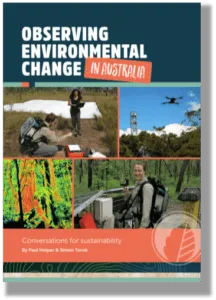Scientell wrote the book Observing Environmental Change in Australia, which describes the science success stories enabled by TERN’s underpinning research infrastructure.
‘Observing Environmental Change in Australia – Conversations for Sustainability’ is a lavishly illustrated 78-page book written by Paul Holper and Simon Torok. It describes the monitoring of environmental change, urbanisation, land-use changes, biodiversity, extreme events, climate, carbon and water.
Client: Terrestrial Ecosystem Research Network (TERN)
Audience: Secondary and tertiary students and teachers, politicians and government departmental leaders, researchers, environmental NGOs, and anyone interested in the environment.

The book celebrates a decade of TERN, the national observatory for Australian land ecosystems. From high-tech monitoring towers in sites hidden deep in Australia’s forests and woodlands to hundreds of plots across the country and drones and satellites observing the landscape from above, the activities of TERN and collaborating NCRIS (National Collaborative Research Infrastructure Strategy) projects help researchers examine the Australian environment at a range of scales.
Book chapters detail the importance of Indigenous knowledge, the use of satellite remote sensing and drones, and managing ‘big data’. The book concludes with descriptions of visualising environmental information, emerging technologies, and the importance of engaging the community.
Observing Environmental Change in Australia describes science success stories enabled by TERN’s underpinning research infrastructure. ‘The book delivers a collection of stories that are engaging, thought provoking and as colourful and diverse as our environment,’ writes Professor Lyn Beazley AO FTSE in the foreword.
‘It is a rich collection of conversations with people who are passionate about the natural environment and its integration with the social, economic, cultural, political, and health aspects of sustainability.’